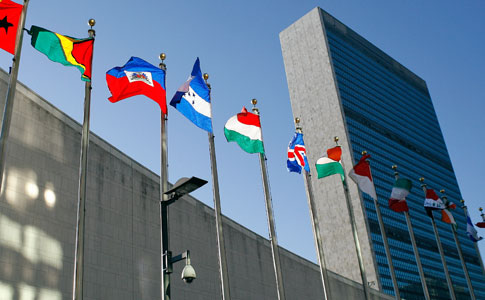NOTE: This guest post was written by Raluca Muresan. Raluca is a 2014 graduate of the School of Diplomacy and International Relations. Her specializations include International Security and Global Negotiations and Conflict Management and her research is focused on the impact of international/regional organizations on conflict and civil disobedience in Europe. She work as an Adminstrator at Control Arms, and is currently contributing to an ATT legal research project on Rules of Procedures for Conferences of States Parties (CSPs), in preparation for the future Arms Trade Treaty CSP.
With the shift from inter-state to intra-state conflicts, for the last two decades, NATO’s role has steadily diminished, leaving many to wonder if the Alliance is still relevant in the 21st century. But the occupation of Crimea and Putin’s impetuous threats, the shooting of a passenger plane and the execution of journalists by rebel groups, are providing the Alliance not only with new challenges but also with a new purpose. Is NATO equipped to take on these challenges? Are the Allies willing to start new and potentially costly conflicts? The decisions made by the leaders of the North Atlantic Treaty Organization in Wales are a close indication that NATO is attempting to return to its former glory, but the process is slow and fraught with uncertainty.
- United against Russia once more
The wars in Afghanistan and Iraq divided the NATO leaders while the global economic crisis shifted their attention from military and security concerns to national economic ones. But the annexation of Crimea and Russia’s involvement in Eastern Ukraine provided them with a new focus on an old enemy. The Wales Summit Declaration condemns Russia “in the strongest terms” and provides for some immediate, if weak, measures: increased sanctions and the creation of a rapid-reaction force. The very high readiness force of several thousand troops able to deploy at very short notice is aimed to reassure the Eastern European Allies worried by Putin’s recent expansionist tendencies. NATO Secretary General Anders Fogh Rasmussen introducing this spearhead force during a pre-Summit press conference stated: “any potential aggressor knows that if they even started to think about attacking a NATO ally they would meet not only national troops from that specific NATO ally but they would meet NATO troops. ” But the Declaration also reassures Russia that NATO poses no threat as it will abide by the 1997 NATO-Russia Founding Act and will not establish any permanent bases in Eastern Europe. As such, what the NATO Summit did was reiterated its commitment to collective self-defense as set forth in Article 5 of the NATO Treaty, while prudently avoiding any provocation towards Russia.
- The Threat of Barbaric Killers
The rampant destruction and instability caused by ISIL [Islamic State of Iraq and the Levant] was also at the top of the agenda during the Wales Summit. President Obama’s goal during the summit was the creation of a core coalition willing to stand against the terrorist group and ensuring the support of the Alliance in combating the transnational threats emerging from the Middle East and North Africa regions. In a joint op-ed Obama and Cameron claimed ISIL is a threat to the Alliance and a national security risk for Britain and America in particular. The Wales Summit Declaration strongly condemns ISIL’s targeting of entire religious and ethnic communities and its destabilizing effects in Iraq. But despite general agreement among NATO leaders that ISIL must be stopped, no firm commitment was made towards sending a joint operation in Syria and Iraq.
- Peace and security are costly
The threat posed by Russia and ISIL to the security of the Ally states provided them with the impetus to breathe new life, and more importantly, more funding into NATO. All members agreed to work towards increasing their defense spending in order to reach the suggested threshold of 2% of their GDP within a decade. Although a necessary measure that would allow the Alliance to address 21st century threats – terrorism, hybrid warfare or cyber-attacks – this decision is neither binding nor a definitive commitment. The Allies also promised to aim to spend 20% of the total defense budget on new equipment and research and development.
- Afghanistan
Although the first item on the Summit’s agenda, Afghanistan was overshadowed by Ukraine and ISIS, as NATO’s focus on foreign campaigns is now being shifted back to national security. The withdrawal of NATO forces from Afghanistan remains to be completed as scheduled by the end of 2014, despite Afghanistan’s disputed elections and concerns that NATOs legacy in Iraq will repeat itself in Afghanistan. The Allies reassured Afghanistan that they remain committed to helping them achieve peace and stability and devised a three step plan in order to achieve this goal. As such, NATO will replace its current troops with a non-combat force that will train and advise the Afghan authorities. In the long term, the Allies extended their financial support for Afghan forces until 2017 and promised to remain committed to the NATO-Afghanistan Enduring Partnership.
- NATO’s door remains open but unreachable
The Wales Declaration reaffirms NATO’s commitment to Euro-Atlantic integration and the Open Door Policy, but no membership or Membership Action Plan (MAP), for that matter, was granted during this summit. Georgia, who greatly contributed to the NATO’s force in Afghanistan, was expected to receive its MAP, which helps pave the way towards full NATO membership. It was rewarded instead with another membership promise and a substantial package that includes defense capacity building, training, exercises, strengthened liaison and enhanced interoperability opportunities. Montenegro, who already received its MAP in 2009, was left hanging as a decision with regards to its membership was postponed until the end of 2015.
